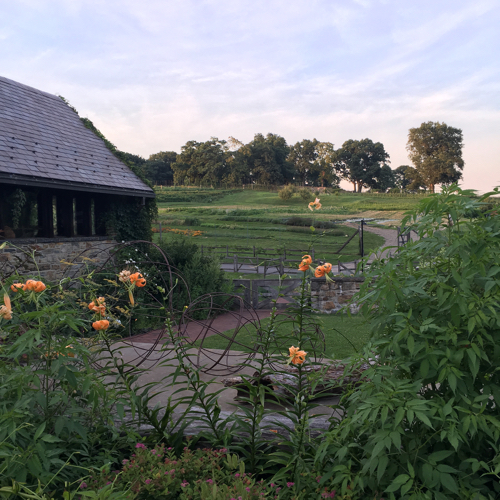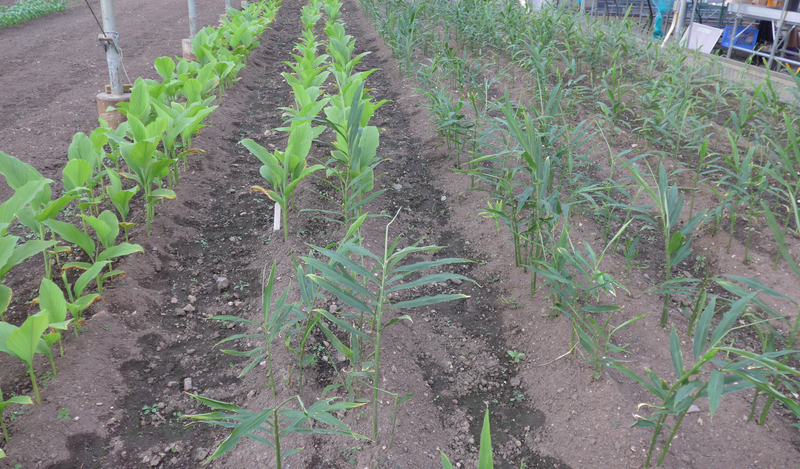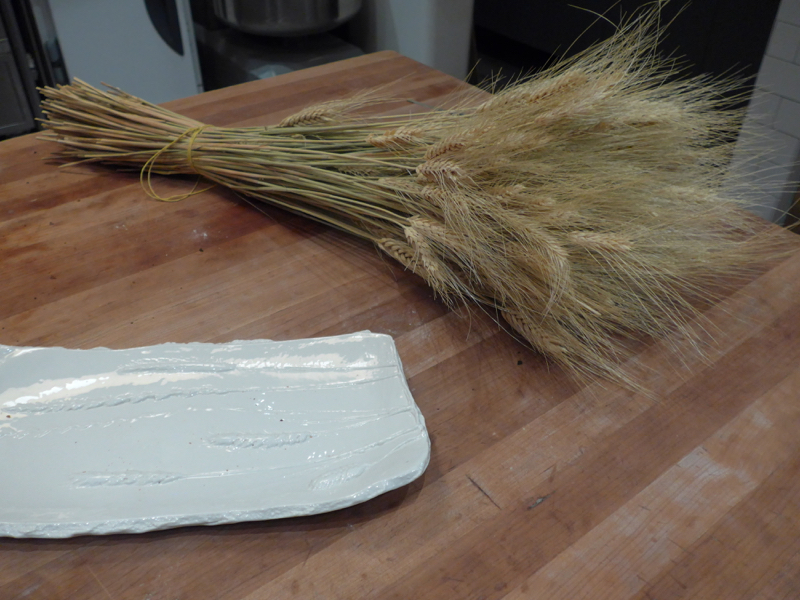Blue Hill at Stone Barns Farm: inspiring sustainable food system in Hudson Valley
Dan Barber’s sustainable food mission has now entered the common consciousness of even these who ignored eco-friendly lifestyle thus far. His best-selling books and two restaurants – one in Manhattan and its younger sister on the farm at Stone Barns herald a respectful relationship between the man and the natural bounty of the fertile Hudson Valley in a tasteful show of field and pasture.
The New York-bred chef employs his wealth of experience from the most sustainable, forward thinking, mindful mavericks, whom he met during his curiosity-driven trips. The boundaryless journeys are described colorfully in his eye-opening book The Third Plate. Enriched with the on-the-farm research of the relative Stone Barns Centre for Food and Agriculture, the chef and his team nurture their mission “to create healthy and sustainable food system”.


Blue Hill at Stone Barns: engaged dining
Just 30 miles north of New York City, training, education, and visionary conventions engage all workers and visitors about agroecological practices. Yet, the most indulgent experience is the farm produce served in the elegant dining room. Staffed with passionate bakers, cooks and servers from around the world, some working there for over a decade, while others whizz through as a part of their hospitality apprenticeship, you penetrate into the “Grazing, Pecking and Rooting” daily changing tasting menu ($238) through their full engagement with you and the produce. Any questions are encouraged, particularly anything touching the themes around the farm.
You feel like being part of nature even inside the restaurant. A birch bark fences seasonal flower arrangement above the fireplace at the welcoming bar. Reeds with blushing daisies and wild grass were the motif of our summer visit. Sip on your aperitif at the classically elegant grey stone bar counter or head on the outside patio overseeing the vegetable gardens. There, during warm days, smoky fragrances escaping from the wood firing grill whet your appetite.
As you take your seat back in the converted barn, wood-beams-laced main dining room, wildflowers nonchalantly bloom in the rustic paint white vases set on the pure clothes dressed tables. For a great break from the packed restaurant, mid-dinner we were taken out into a separate barn for a romantic course of a thin-crust POTATO PIZZA topped with SMOKED CORN, TOMATO and MOZZARELLA. Sitting between the burning candles and listening to the crickets, we realised how different their songs are from those of our home’s Mediterranean species. On our way back to the restaurant were introduced to the bakery.
Art of baking from freshly milled grains
Here, Barber wheat, naturally lower in gluten, as well as other new breeds such as “skagit 1109” and other grains bred by the University of Washington agricultural team are being freshly milled and baked daily on the premises. The fragrant oils from the grains spoil easily, but they reward with more complex and fragrant bread that is moist in the centre with a chalky brown crust from the needed prolonged baking. We got a loaf to take home after our hours-lasting meal was over. While I heated the wheaten loaf in the oven at the culinary school next day, the aroma teased the entire kitchen, and these foodies loved the freshly milled bread as we did. The nose-tantalising aromas make the bread delicious on its own. The university trials plenty of resistant and flavourful plants such as the creamy textured potatoes “ny-150”, the ever expanding breeds of tomatoes (“cornell 79”, “iron lady”, …) and winter squashes (“amber delight”, “robin’s koginut”, “trombocino”, …).

Celebration of the field and pasture
Before you dig into the tasting, a small notebook organised according to a typical monthly harvest suggests which crops may appear on your plate. There is a space left for your observations to note down anything captivating. Additionally, the chefs and cooks are encouraged to forage daily for seasonal berries, wild herbs, and mushrooms. One of our plates was covered with foliage and branches under which we discovered a berry filled pastry cup, one bite for each of us. Leftovers are well looked after as the refreshing CORN COB LEMONADE served later during our meal attested.
The locally bred and grown ingredients are impressive pursuits deserving more involved attention given to them at the farm and the Blue Hill. Right at the beginning of our August tasting, an edible display of pea and yellow stripped flowering courgettes, Jamaican spiky cucumber, mini balls of radishes, baby peppers, cherry tomatoes and crispy lettuce hearts – all showing off – spiked on the pins for us to pick and devour. Minutes later, a giant kohlrabi decorated our tables just before it was taken back to the kitchen and wrapped into KOHLRABI BURRITO with CHARCOAL MAYONNAISE. The delectable fate was also destined for the freshly picked vegetable basket presented to us. Creative plates of ZUCCHINI STEM BOLOGNESE cut into a rigatoni pasta shape and HUBBARD SQUASH, TOMATO ROMESCO with PORK SNOUT superbly underlined the veggies. The produce show was just heating up as a snake-like tromboncino squash winded around a waiter’s arm came to our attention. The harmless plant-flesh cobra was served originally as TROMBONCINO SQUASH, YEASTED POTATOES AND BONE MARROW. We could see most of these perfected crops inside the farm’s greenhouse where new varieties are bred for “flavor and resilience”.
The GREEN GARDEN GAZPACHO is a staple on the menu and appeared on the same night on the a la carte menu at the Manhattan Blue Hill restaurant. A friend of mine was dining there on the same evening so we were able to compare our meals. For example, there was no fish in our multiple-course dinner, but a sweet and sour flavoured striped bass featured at the Blue Hill in New York. The main difference of the farm restaurant though is that the meal is much longer, involves way more courses and overall is more complex and filling. The city Blue Hill allows you pick your dishes, so diners preferring the security of their own choice should rather eat there. Those, who indulge in the surprise tasting, open the gate of your palate, and indulge!
The off-the-beaten-path culinary wizardry continued in the plating of the pasture produce. A PIG POPCORN, then FREEDOM RANGER CHICKEN IN LEVAIN with MALABAR SPINACH as well as the BERKSHIRE PORK, BERRIES AND LOVAGE satisfied our animal protein cravings. Chickens, geese, pigs, turkeys, and sheep freely graze and peck on what the farmland offers. When we were checking out the barns before our dinner, a group of turkeys angrily ran after us so escaping their voracious and sharp beaks turned into desire with question marks: when are the turkeys served? As the farm’s Vice President Irene Hamburger expertly clapped them away, she said that they will be ready for the fall tables and thus delayed our masochist revenge perhaps to our next meal at the Blue Hill. You, turkeys, I cannot wait to bite into your stuffed yummy flesh this Thanksgiving!
Such focus on the pork meat brings about the main criticism we had of the Blue Hill dining experience. To be even more sustainable, even less meat should appear on Dan Barber’s daily changing tasting menu. The delicious cauliflower “steak” served at his NYC restaurant is one starry example. Eschewing the carbon-guilty beef was the first step, adding leftover bone marrow from involved butchers another, while tip (frond) to root cooking is what he does best, all efforts to improve the restaurant’s ecological credentials.
DRINKS: An aperitif at Blue Hill does not need to involve alcohol. The maple sweet chufa nut milk, beet yoghurt-based lassi, single grape varietal juices from California, locally made flavoured soda, and various flavours of kombucha (fermented tea beverage that is very low in alcohol) are all great and seductive options.
The more potent by the glass selections such as a sparkling French cider, New York draught beer, sherry, and other global aperitif staples can be ordered on the terrace outside. I tasted the rather unusual white Pinot Noir from California but went for a glass of Burgundy that was more intriguing for my palate. The sommelier gave me a taste.
The broad wine list stands to the merits of the restaurant. Our pick of Calera Selleck Pinot Noir 1989 from Mount Harlan in Napa Valley, was a savoury red wine with a bright acidity despite its old age and deep, earthy aromas. A corkage of $90 is charged per bottle (only one is allowed per two guests), so if you come often bring your own.
If you still have a room for a digestif then the vintage Madeiras spanning back a century may conclude an indulgent outing with a perfect night cap.
For a non-alcoholic farewell, the tea menu is extensive – a bounty of white, green, oolong, black and pu’erh teas, next to caffeine-free herbal infusions from the garden and seasonal brew coffee. I ventured in for the Almond blossom tisane, rather unusual but a fragrant dot after the decadent meal.
Sustainable farming practices
No pesticides are needed as selective animals introduced to the farm eat the pests. Natural compost takes care of the soil fertility. The Stone Barns Centre for food and agriculture sparks innovation while sustainably nourishes good soil by employing a seven-year crop rotation plan, raises “happy” animals grazing on the rotating pastures and is devoted to plant diversity (500 varieties to date and growing) and mindful food choices. Bees are welcomed on the farm so a little apiary was built for them to rest and make honey as well as pollinate freely as much as they like.
At the Stone Barns, the varietal diversity is being re-injected back into the impoverished American soil. The country that diminished its biodiversity so alarmingly, that plant species die as fast as the rural languages, needs farms like the Stone Barns to align itself with the natural clock. With a hindsight, we know a reductionist system will not feed us. Particularly in the world where every day welcomes more people than ever, we must encourage and nurture our soil as our land-minded ancestors did.
Read more about the FUTURE OF FOOD.
Blue Hill at Stone Barns 630 Bedford Rd, Pocantico Hills, NY 10591.
+1 914 366 9600
Wed-Sat for dinner 5-10pm; Sunday lunch & supper 1-9pm
Cafe & bakery opened Wed-Sun: 10am – 4:30pm. Blue Hill’s savory vegetable flavored yogurts from grass-fed cow’s milk, honey, jam, pastries, and other deli items are sold there.
NOTE: Saturday and Sunday visitors to the Café require admission tickets to Stone Barns Center for Food and Agriculture. The tasting menu is available at the more casual bar counter for $188 and can be reserved up to 2 days in advance.
PHOTOS BY: Radka Beach, Susie Cushner, Jonathan Young.





















